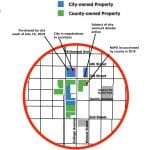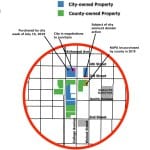Commissioner on land contributions from city, county for convention center expansion: “We are really far apart on this one.”





After meeting for more than two hours on Monday night, city and county officials were maybe incrementally closer to hammering out an interlocal agreement that’s meant to help move forward a $44-million convention center expansion project.
The current convention center is located at College Avenue and 3rd Street.
On Monday, elected officials reviewed the newest draft of the interlocal agreement, which is intended to supplement statutory requirements for the eventual formation of a capital improvement board (CIB).
Sticking points are the same as those identified at a meeting earlier in the year: the way appointments are made to the convention and visitors commission; and which parcels of land will be contributed to the new CIB by the two sides.
Of the two topics, it’s the land contributions where city and county officials have the more serious disagreement. President of the county commissioners, Julie Thomas, said about the land issue: “We are really far apart on this one.”
The city wants to see all the city- or county-owned land in the vicinity of the convention center put at the disposal of the CIB. County officials want to contribute just the parcels to the CIB that are known to be needed for the current project. [city proposal] [county proposal]
The two sides are hoping for a next meeting on March 2.
May 19 will be the one-year mark for the time the project has been stalled, since a steering committee voted to recommend a northward instead of an eastward expansion of the existing convention center facility. The yet-to-be-formed CIB is supposed to make the final choice of the site plan.
The interlocal agreement is supposed to set the terms of the “equal” partnership between the city and the county.
The agreement covers allocations of appointments by the city and the county not just to the future CIB, but to the existing five-member convention and visitors commission (CVC). The appointments to the CVC are currently made by the county council and the county commission.
A key point clarified by county attorney Jeff Cockerill at Monday’s meeting is that one of the five appointments is almost fully dictated by the statute. It goes to “the director or associate director of the Indiana University Memorial Union.”
It’s the four other appointments that the city and county lawyers tried to divide equally. The wrinkle is that three of the other four appointments have a statutory restriction that they be “owners or general managers of a hotel or motel having at least forty (40) beds that is located in the county.” So the one “unrestricted” appointment is a point of friction: Does the city or the county get the unrestricted appointment? One possibility raised on Monday is that it could alternate from year to year between city and county.
Another aspect of the disagreement is how the city can make the appointments, which under the state statute are the county’s to make. County councilor Marty Hawk takes the position, which she reiterated on Monday, that the interlocal agreement can’t do anything more than say that the county will consider the city’s recommendation. She’s always happy to consider recommendations, Hawk said. The statutory authority to make the appointments rests with the county, Hawk said, and the interlocal agreement can’t change that.
Most others around the table on Monday appeared to think that the principle of “home rule” gives the city and county the ability to make whatever arrangements they like with respect to the CVC appointments. The idea of recommended “panels” is meant to strike some middle ground between (1) granting to the city the right to make the appointments and (2) having the county merely consider recommendations, but be free to appoint the people it wants.
The idea of “panels” is that the city could put forward a set of at least two possible people for each appointment. The county would be obligated to choose one from the city’s proposed panel. Bloomington’s mayor, John Hamilton, didn’t think that squares up with the idea of equal representation—because the county would not have to put forward a panel for its own appointments.
Those around the table on Monday were willing to declare some forward movement on the appointments issue before they moved on to the issue of land contributions.
It became apparent on Monday that a challenge of the interlocal agreement will be to capture the equality of the partnership in a way that respects the tax monies contributed by each side.
The city is pledging its entire share of the food and beverage tax to the construction project—that’s 90 percent of the more than $3.4 million per year the 1-percent tax has generated in the 23 months since it has been collected.
As part of its contribution, the county counts the history of the innkeeper’s tax starting from 1999 and projected 25 years into the future. That totals around $111 million, based on a county spreadsheet reviewed by The Beacon. One chunk of the innkeeper’s tax (40 percent) is used to pay the maintenance and debt on the existing facility. Another chunk of the innkeeper’s tax (60 percent) is allocated to Visit Bloomington for tourism promotion.
The county analyzes the city’s contribution over the 25-year bond period as totaling $81 million for the expanded facility, paid out of the food and beverage tax, and $20.6 million for the parking garage paid out of city TIF revenues. On Monday, this was the kind of calculus that lurked in the background.
City council president Steve Volan wondered at Monday’s meeting if there is a list of all the property that the county has purchased with innkeeper’s tax revenue. The city wants to see all the land in the vicinity of the existing convention center, owned by either side, contributed to the CIB. Volan thinks the currently planned expansion will be so successful that he sees the possible need to expand it again following quickly.
Hamilton also raised the question of what should happen if, in five years, the CIB came to the county and asked to purchase one of the un-donated parcels. What would the answer be? One idea Hamilton spitballed at Monday’s meeting was to stipulate an option for the CIB to purchase the land for $1.
Another section of the agreement that could prove to be problematic got a brief mention towards the end of Monday’s meeting. It’s towards the end of the document, and covers the question of the parking garage component of the new facility.
One possible draft reads: “Garage should be operational on or before the completion of the expanded Convention Center. If not, the City, in collaboration with the CIB, shall provide alternative parking arrangements for the period prior to completion.”
About that section, city councilmember Matt Flaherty said he wanted to see the desired sustainability features of the project more fully incorporated in the draft of the interlocal agreement. He said he was reluctant to approve future TIF funds for a parking structure.
Important factors for Flaherty are pricing the parking in the replacement 4th Street parking garage to cover the actual cost of the construction and possibly using shuttles between the convention center and the airport. Circulators between the convention center and the hospital parking structure that the city will be taking over are also a possibility that Flaherty thinks could be included in the interlocal agreement




Comments ()